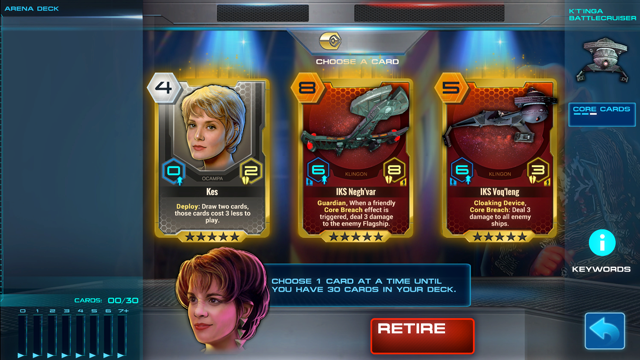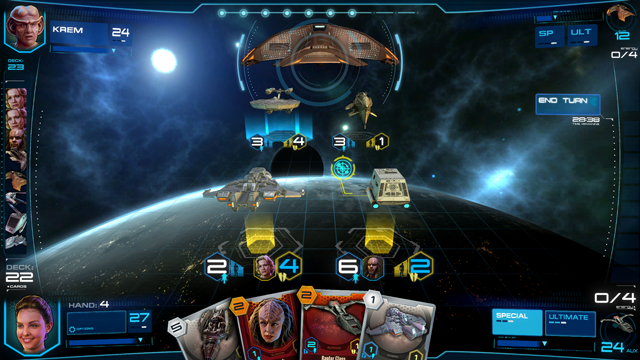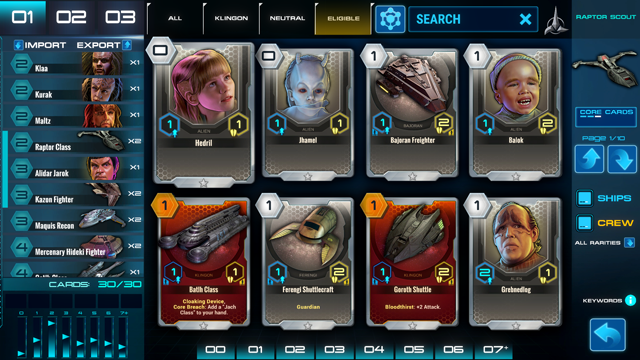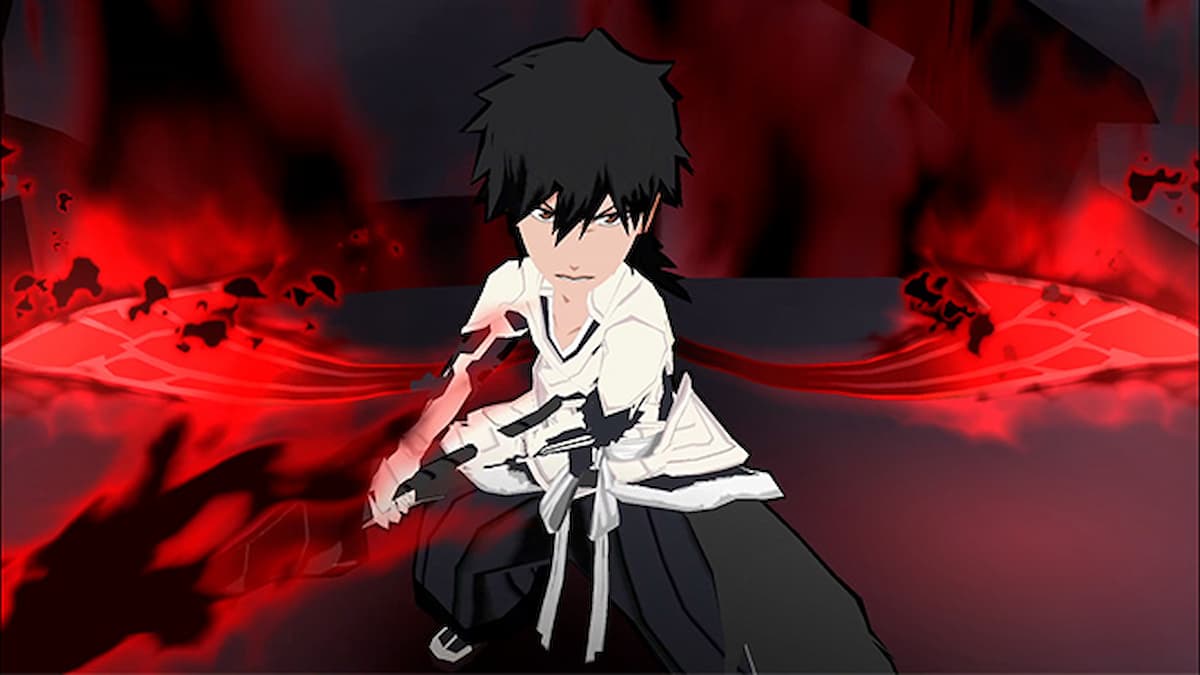In Star Trek Adversaries, players take the captain’s seat in charge of their own flagship and fleet of smaller vessels. Using your personal-built deck of ships and crew members, you wage war against another player or the computer in a battle to destroy your opponent before they can destroy you.
Jumping in From Other Games
Players familiar with Hearthstone and other games which have built off of the juggernaut’s established structure will find Star Trek Adversaries to be an easy transition. Like those games, each player has a main class they’re playing as (their flagship) with unique abilities. Each player deploys cards to the battlefield (ships) which include attack and defense ratings, and generally do damage both in attack and defense. Cards are paid for with energy from your pool, which starts out as just 1 on your first turn and increases by 1 each round; and each player seeks to deal enough damage to the enemy flagship to reduce its health to 0 and win.
In addition to the change of names for established game mechanics (Deathrattle becomes Core Breach, for example) there are four main areas where Adversaries differentiates itself from the crowd.
- Flagship powers work differently than Hero powers. For starters, each ship has both a Special power and a more powerful Ultimate, instead of just one hero power. Additionally, instead of costing standard energy, your powers charge up on their own scale, with unspent card energy on your turn being transferred over to prepping your powers more quickly.
- Each ship has slots to attach crew to upgrade it. The effects of a crew card can be basic, either increasing its attack if placed in a Commander slot, or its defense if placed in an Engineer slot, or more complex by adding keyword effects to the ship.
- Each player can only have four ships in the playing area at a given time, fewer than in its competitors.
- Ships on the battlefield can be retreated back into your hand, earning energy you can spend that turn to deploy a different ship.
Card Text Keyword Glossary
The most important part of getting started with a competitive card game is understanding what every card does. If you come across a word on a card and don’t know what it means, you can’t plan effectively, so check out this glossary to go into battle informed.
- Bloodthirst: An effect triggered when the ship takes damage
- Cloaking Device: Grants stealth on a ship if it did not act this turn
- Core Breach: An effect triggered when the ship is destroyed
- Commander: An effect which requires crew in the commander slot to be used
- Disabled: Can’t attack for one turn
- Engineer: An effect which requires crew in the engineer slot to be used
- Guardian: This ship must be destroyed before your flagship can be attacked unless this ship has stealth engaged
- Haste: This ship does not require a round to get ready before attacking
- Jamming: This ship does not take damage when initiating an attack
- Modulating Shields: Prevents all damage from the first attack on this ship
- Neutralize: Negates all effects on a target ship other than crew-based stat increases
- Play: An effect triggered when a card enters the battlefield
- Retreat: An effect triggered when a ship retreats
- Stealth: This ship can’t be attacked directly. Attacking with this ship removes stealth.
- Trample: Excess attack above the defense of the ship you attack is passed on to the enemy flagship
Choosing a Flagship
The first big choice when setting out to conquer space is which flagship you’ll be taking control of. Starting out you’ll have access to six ships, three from the Federation and the three from the Klingons, but there are lots more to unlock. Every flagship has two unique powers and each can be powerful with the right supporting deck.
Federation Flagships
The NX Class specializes in bringing more ships onto the battlefield for an immediate offense. Its special move brings a 2/1 Shuttlepod Prototype with Haste into play, while its ultimate calls in a 5/1 Ganges Class with Haste. This is the Federation’s most offensive starting flagship.
The Excelsior Class flagship is here to recycle your deck and take advantage of Adversaries’ unique retreat function that grants energy in exchange for removing an active ship back into your hand. For its special, you can retreat a friendly ship while your ultimate allows you to retreat any ship in play.
The Constellation Class flagship excels at buffing your ships. Its special grants Modulating Shields to a ship with 4 or less attack, allowing it to take on an enemy once without taking damage. With the Ultimate, the Modulating Shields effect remains but a +4/+4 buff is also included making it an instantly formidable force.
Klingon Flagships
The QoJ Class Klingon flagship allows you to load your hand up with discounted cards. As a special, you can return a ship to your hand while lowering its cost by 2. This is particularly useful for ships with valuable Play abilities. The ultimate reduces the cost of every card in your hand by 2, an incredibly valuable move if you’re at or near a full hand.
Players fielding a Raptor Class flagship use their opponent’s aggression against them by taking advantage of Core Breach effects. The special calls forth a 2/1 Escort Transport, which in turn produces a 1/1 Rescue Transport when defeated. Calling on your ultimate grants a +4 attack to a ship, and makes its Core Breach effects trigger twice when destroyed.
Deck Building
Like most online competitive card games, the core of Star Trek Adversaries is the deck construction system. Using your pool of cards you can build a deck containing 30 of them to take into battle with you. The three essential elements of your deck to keep an eye on are card costs, your ship to crew ratio and your deck synergy.
Cost matters
The key to building an effective deck in Adversaries is balance. A deck full of 1 and 2-cost cards will let you flood the board early on as nearly every card you draw will be playable, but as energy levels get higher your ships will be overpowered as your opponent starts playing 5-energy cards or more. On the flip side, a deck of only expensive cards is formidable late in the game, but you’re unlikely to survive long enough to put it to good use.
Thankfully the deck-building interface includes a handy gauge showing what types of card your deck includes. By shooting for a deck that is mostly average cost cards, between 2 and 4-energy, balanced out by fewer cheap cards to get started and expensive cards for the late game, you’ll create a balanced and effective deck.
Balance your resources
Crew cards are useful tools for beefing up your ships, but they’re useless without ships to put them in. If you load your deck up with too many crew members you’ll constantly be dealing with a hand full of crew members and nothing to do with them. You should avoid crossing into double-digits with your crew and ideally have at least three ships for each crew member.
Teamwork makes the dream work
The most important part of constructing your deck is having cards that work together. You can’t choose what order you draw them, so it’s important that every card has multiple other cards in the deck it works in concert with. For example, a deck with lots of Core Breach power cards and crew members capable of triggering Core Breach effects is a theme that creates a well-oiled machine on the battlefield.
Game Modes
Although there are plans to add additional modes, there are currently three ways to play Star Trek Adversaries.
Single Player Practice
The best way to test out a new deck without risking your ranking is to take it the practice arena and do battle with an AI opponent. Whether you’re trying out a new strategy or simply don’t want to take an online opponent at the time, practice mode is a stress-free way to get your feet wet.
Ranked Multi-Player
The heart of any online card game is the multiplayer ladder. In ranked play, you start out with a default rating for new players, and everything from that point forward comes down to your results in competitive matches. The client will match you up with opponents of a similar rank, and winning matches moves your ranking up while losing moves you down. This helps to keep online play fun as you will always have the best possible chance of getting a fair match-up.
Quark’s Single Player Draft Holo-Suite
The offline draft mode is a fun way to experiment with new decks and try out cards you haven’t had a chance to play, as well as a way to earn new cards and other perks. In a draft game, a player chooses a flagship then is put through 30 rounds of card drafting. In each round, the player is presented with three cards and chooses one to add to their deck. Once a full 30-card deck is constructed that deck is taken into battle against a series of AI opponents. Each time you win you will earn credits to spend on unlockable perks, but beware because three losses mean the end of your run and the loss of unspent tokens.

Drafting the right deck revolves on two key principals. Always enter with a plan, and don’t be married to that plan. Having a goal in mind for your deck can help with decision making on those first few rounds, but don’t make it your only priority. Whether there are simply no good cards for your plan, or great cards which don’t fit it come out in the early rounds, you may have to change your plans. Once you have drafted five or six cards, you have enough in your deck to start basing future picks on maintaining synergy throughout the deck.
Filling Out Your Deck
Although the game starts you out with a starter set and a few free packs, if you want to open up your deck-building options you need more cards. As with all online card games, there’s the option to purchase new packs, but you don’t need to spend money to make your deck better. There are two simple ways to earn new cards by doing what you’d do anyhow — playing the game!
Playing in Quark’s drafting game is a great way to unlock new cards. Options available for purchase with Quark’s credits include purchasing currency, replicators to make specific cards, or new packs to open.
If you prefer the standard game with your built decks, don’t worry. Every player has missions they can take on in order to earn packs or currency. Missions range anywhere from playing certain types of cards to winning matches in certain game modes, so be sure to open your missions tab and see where you have the opportunity to earn before starting up your next match.
Star Trek Adversaries is a fun entry into the online card game sphere which puts its own twist on the established formula. Have you been playing Adversaries? Tell us about your favorite strategies in the comments.








Published: Aug 24, 2018 05:59 pm